Have you ever been curious whether shrimp are good for freshwater aquariums?
Shrimps make a great addition to a freshwater tank environment thanks to their low maintenance requirements. They also help to keep your tank clean.
Read on to discover why shrimp are great beginner invertebrates for your tank and which ones will be best suited for your aquarium.
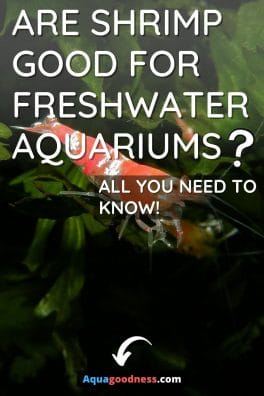
Table of Contents
Why Shrimps Are Good for Freshwater Aquariums
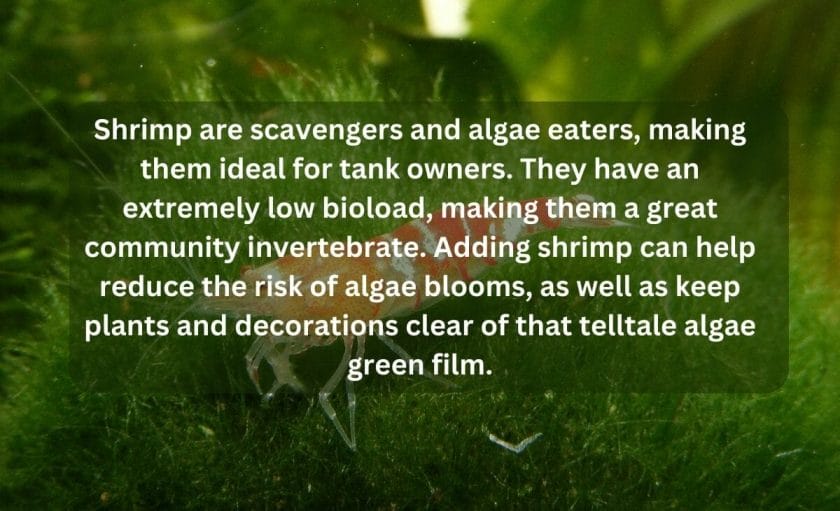
Shrimp are amazing pets and something every aquarist can appreciate in their tank. These little invertebrates are incredibly entertaining, always scurrying around in search of decaying organic matter or algae.
While their bright colors and constantly active nature are reason enough to add shrimp to your tank, freshwater shrimp also serve an important role: algae control.
Algae Eaters
Shrimp are scavengers, constantly filtering at the bottom of the tank or on your decorations and plants to find food.
One of their main sources of food is algae, which is ideal for you as a tank owner because algae blooms can destroy the aesthetic of your tank, turning it into an icky green color.
Large blooms can reduce oxygen flow in your tank, and some types of blooms emit harmful chemicals.
Shrimp will not solve an algae bloom, but introducing shrimp into your tank can help reduce the risk of a bloom, as well as keeping your plants and decorations clear of that telltale algae green film.
Low Bioload
Another great reason shrimp are amazing in a tank setting is that they have an extremely low bioload.
Bioload is the measure of how much waste a creature produces in a tank setting, and too heavy of a load can cause ammonia and nitrite spikes because the beneficial bacteria cannot keep up with all the waste being produced in the tank.
You can add 5 shrimp per gallon in your tank, depending on how stocked your tank is already. Should you choose, you can stock a smaller tank with only shrimp. Take it from me: shrimp tanks are always full of life and vibrant in color!
A Great Community Invertebrate
You can also include shrimp safely with a number of other fish. Of course, you should avoid tankmates that are predatory in nature, since they will eat your shrimp!
With that being said, choose your tankmates right, and you add a splash of color along the floor of your tank without harming the ecosystem or social environment of the tank.
Tankmates to Consider
Here are some good tankmates for shrimp:
- Danios
- Guppies
- Most plecos
- Tetras
Why Shrimps May Not Be Good for Your Aquarium
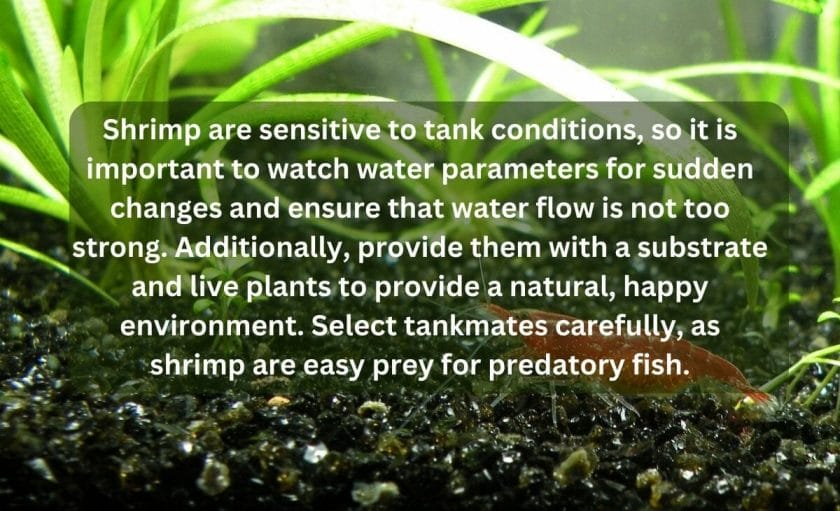
Of course, shrimp aren’t perfect for every aquarium, and you can’t just thoughtlessly dump them into a tank and expect them to survive.
Shrimp Are Sensitive to Tank Conditions
Shrimp are a lot more sensitive to water changes than other fish, and different species prefer different water parameters.
When conditions in your tank change abruptly–think algal bloom, disease, or ammonia spikes–shrimp will be the first to suffer. While there’s not much maintenance involved in caring for shrimp, watching your water parameters for sudden changes is a must.
In addition, you’ll want to ensure that your water flow isn’t too strong; shrimp are small and will not have a good quality of life in a fast current tank. Avoid pairing shrimp with fish who enjoy medium or strong current.
Additionally, you’ll want to provide your shrimp with a substrate (no bare-bottomed tanks) and lots of live plants in order to give them a natural, happy environment.
Shrimp Are Easy Prey
As mentioned above, you’ll need to select your tankmates carefully. Shrimp are small, tasty snacks for some predatory fish, and others with aggressive natures can bully and harass your shrimp.
Tankmates to Avoid
Some examples of poor tankmates include the following:
- Gouramis
- Most cichlids
- Goldfish
- Oscars
- Jack Dempseys
- Angelfish
Which Shrimp Are Best for Beginners?
Some shrimp are easier to manage than others, and this helpful breakdown below will help you discover the best shrimp that will add a beautiful splash of color to your tank floor!
Cherry Shrimp
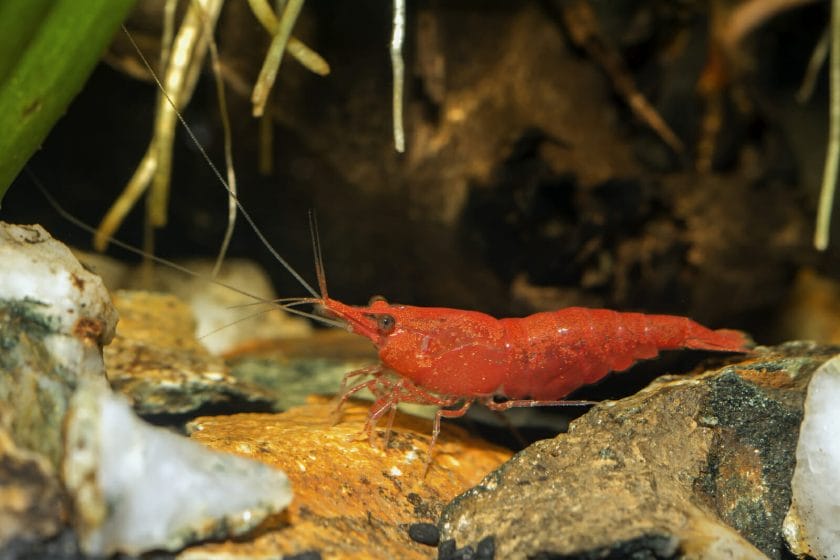
| Scientific Name | Neocaridina davidi |
| Water Temperature Range | 68-78 °F |
| Water pH | 6.5-7.5 |
| Minimum Tank Size | 2 Gallons |
| Lifespan | 1-2 years |
| Diet | Omnivorous |
An extremely common variant, Red Cherry Shrimp have a bright red color and are extremely easy to care for and can blend into a diverse aquatic environment.
They feed on detritus and algae in a tank. Higher temperatures (close to the 78°F mark) will prompt them to reproduce more frequently.
Amano Shrimp

| Scientific Name | Caridina multidentata |
| Water Temperature Range | 68-78 °F |
| Water pH | 6.5-8.0 |
| Minimum Tank Size | 5 Gallons |
| Lifespan | 2-3 years |
| Diet | Omnivorous |
Amanos are algae-chomping machines, ranking right behind Cherry Shrimp in popularity.
Their translucent body is marked with red-brown or blue and green spots. Amanos are quite hardy, able to withstand a variety of tank conditions, and they thrive in planted tanks.
Ghost Shrimp
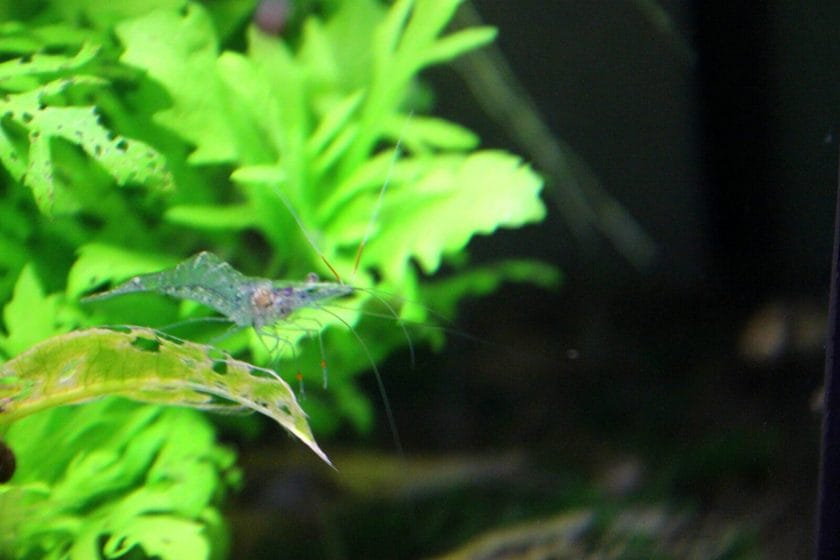
| Scientific Name | Palaemonetes paludosus |
| Water Temperature Range | 65-85 °F |
| Water pH | 6.5-8.0 |
| Minimum Tank Size | 5 Gallons |
| Lifespan | 1-2 years |
| Diet | Omnivorous |
Ghost Shrimps are transparent and have a glasslike appearance. These shrimp have a shorter lifespan of around 6 months compared to the average 2-3 years, which is likely due to their sensitivity.
Provide lots of planting on the flooring of your aquarium for hiding places, and you’ll even be able to pair these shrimp with a Betta, since the Ghost Shrimp are too large to be eaten.
Crystal Shrimp

| Scientific Name | Caridina cantonensis |
| Water Temperature Range | 70-76 °F |
| Water pH | 6.0-6.9 |
| Minimum Tank Size | 5 Gallons |
| Lifespan | 1-2 years |
| Diet | Omnivorous |
Crystal Shrimps come in a rainbow of colors and are gorgeous in a tank setting, although they do require some more finicky temperature control.
These shrimp aren’t great in community settings, but nonaggressive fish can be compatible.
Blue Dream Shrimp
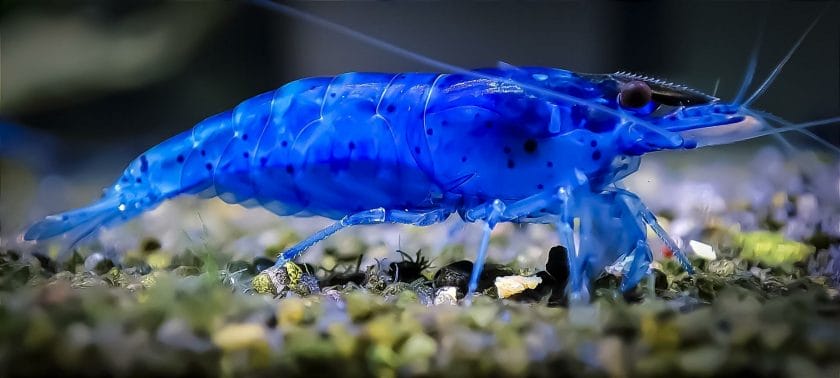
| Scientific Name | Neocaridina davidi |
| Water Temperature Range | 65-76 °F |
| Water pH | 6.5-7.2 |
| Minimum Tank Size | 5 Gallons |
| Lifespan | 1-2 years |
| Diet | Omnivorous |
Basically a blue recoloring of the Red Cherry Shrimp, Blue Dream Shrimp are a great clean up crew and can pair well with other nonaggressive fish.
They take care of themselves, and as long as you keep water parameters in ideal range, you can expect them to live for 1-2 years.
FAQs
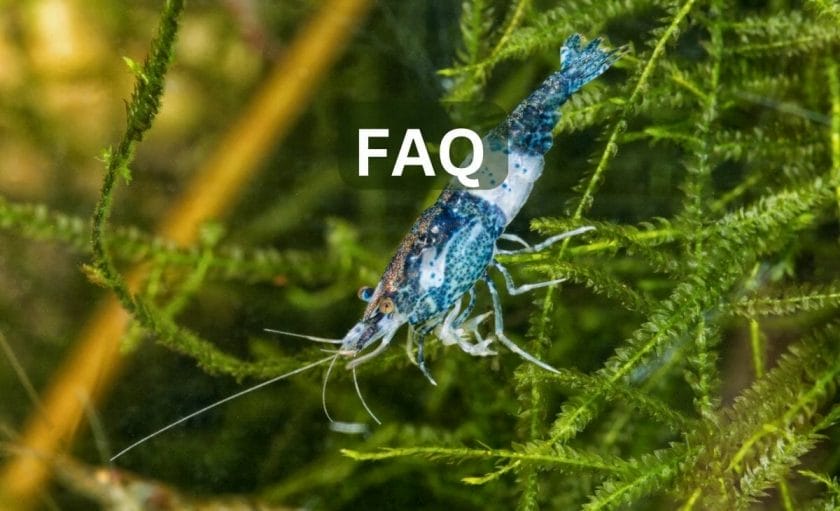
What Are Shrimp Good for in an Aquarium?
Shrimp are great natural scavengers, eating decaying organic matter and algae to keep the tank parameters within an ideal range. In addition, they provide interest and movement at the bottom of the tank that contributes to a thriving and active tank environment.
Are Shrimp Easy to Take Care of?
Not only are shrimp great for many freshwater tanks, but they’re also super easy to care for. Feed them once daily with Hikari Shrimp Cuisine and keep your tank conditions amenable for these little invertebrates, and they practically take care of themselves!
Conclusion
Shrimp are great additions to most freshwater tanks, whether you’re doing a shrimp-only tank or a community tank. Their low bioload, beautiful color, and easy care requirements make them a perfect beginner invertebrate.
I hope you found this article explaining why shrimp are great additions to your tank helpful, and make sure to take note of the top 5 freshwater shrimp for beginners to get your freshwater aquarium started on the right foot!